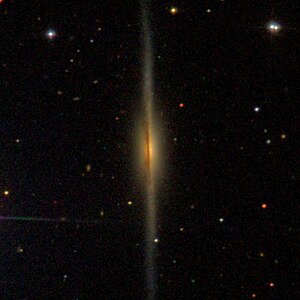NGC 4289
| Galaxy NGC 4289 |
|
|---|---|

|
|
| SDSS recording | |
| AladinLite | |
| Constellation | Virgin |
|
Position equinox : J2000.0 , epoch : J2000.0 |
|
| Right ascension | 12 h 21 m 02.4 s |
| declination | + 03 ° 43 ′ 22 ″ |
| Appearance | |
| Morphological type | SA (s) cd: / sp / HII |
| Brightness (visual) | 13.6 mag |
| Brightness (B-band) | 14.2 mag |
| Angular expansion | 3.9 ′ × 0.4 ′ |
| Position angle | 1 ° |
| Surface brightness | 13.9 mag / arcmin² |
| Physical data | |
| Affiliation | Virgo cluster LGG 281 |
| Redshift | 0.008733 ± 0.000003 |
| Radial velocity | 2618 ± 1 km / s |
|
Stroke distance v rad / H 0 |
(113 ± 8) · 10 6 ly (34.7 ± 2.4) Mpc |
| history | |
| discovery | Ernst Wilhelm Leberecht Temple |
| Discovery date | 1877 |
| Catalog names | |
| NGC 4289 • UGC 7403 • PGC 39886 • CGCG 042-038 • MCG + 01-32-015 • IRAS 12184 + 0400 • 2MASX J12210230 + 0343190 • VCC 449 • GALEX ASC J122102.38 + 034318.5 • LDCE 904 NED056 • EVCC 2077 | |
NGC 4289 is a spiral galaxy with extensive star formation regions of the Hubble type Sbc in the constellation Virgo on the ecliptic . The galaxy is an estimated 113 million light years from the Milky Way and is approximately 135,000 light years across . She is listed as a member of the Virgo galaxy cluster under catalog number VCC 449 .
The galaxies NGC 4234 , NGC 4292 , NGC 4301 , NGC 4303 are located in the same area of the sky .
The object was discovered in 1877 by the astronomer Wilhelm Tempel using his 11 inch telescope .
Web links
Commons : NGC 4289 - collection of images, videos, and audio files
